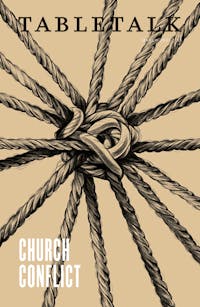
Request your free, three-month trial to Tabletalk magazine. You’ll receive the print issue monthly and gain immediate digital access to decades of archives. This trial is risk-free. No credit card required.
Try Tabletalk NowAlready receive Tabletalk magazine every month?
Verify your email address to gain unlimited access.
The history of the church is filled with doctrinal conflict. Modern Christians may think that such conflict is a new phenomenon caused by our distance from Jesus’ teachings and the early church. But in the first couple of centuries of the early church, significant theological differences were debated and eventually decided by church councils such as those at Nicaea and Chalcedon. How, then, should doctrinal conflicts be resolved? The good news for us is that we do not need to guess or come up with a model or method—in Acts 15, the Holy Spirit has given us an inspired account of how to deal with doctrinal conflict.
step one: recognize the conflict and seek help
Acts 15 begins with a familiar event: a conflict arises in the local church because men taught what they believed was a required doctrine for the church (Acts 15:1). This was not in accord with the local church’s teaching, so Paul and Barnabas contended with them, resulting in “no small dissension and debate” (v. 2). Rather than split the church or “agree to disagree,” the church leaders sent a group to Jerusalem to seek help. They knew that this doctrinal issue had significance beyond their local assembly and sought the broader church’s wisdom. In the same way, when doctrinal conflict arises in the church today, we should recognize that it is best to seek a resolution instead of letting that conflict fester and cause division. The church should be united in its testimony before a watching world. Seeking help beyond the local church is readily available in my Presbyterian context, which has a series of graded courts to which appeal can be made. But even in a congregational context, a group of like-minded churches can be called together to address doctrinal conflicts.
step two: the church gathers to settle the conflict
Seeking help is valuable only if the broader church is willing and able to help settle doctrinal conflicts. That is what we see the church doing in Acts 15. Paul and Barnabas bring the issue to the church in Jerusalem, and “the apostles and the elders were gathered together to consider this matter” (v. 6). This was not a popularity contest or a desire to find a compromise to avoid the harmful effects of conflict, but the Apostles and elders gathered to search the Scriptures and debate the issue. We do not have a transcript of the debate. Still, we see both Peter and James applying the truth of God’s Word—including its teaching on justification by faith and Old Testament prophecy of the calling of the gentiles—to resolve the conflict. Today we would be wise to follow the example of the early church in coming together and resolving doctrinal disputes. The history of the church is filled with examples of such resolutions to guide us. Old conflicts have arisen again (such as certain formulations about the Trinity), and new applications in our contemporary culture of established teachings have caused conflict in the church (such as the nature of temptation and sin).
step three: publishing the resolution to the conflict
After concluding the question whether circumcision is required for salvation, the church took the important step of drafting a letter and sending its decision to the congregation at Antioch and beyond. This was not only to resolve the doctrinal issue but to “encourage and strengthen” the churches through the decision. The doctrinal difference had brought a breach in the peace of the local church and hampered efforts at evangelism and missions.

The Jerusalem council ended that crisis through its authoritative pronouncement. We may wonder whether such a solution is possible for the church today, considering that we do not have Apostles like Peter and James to “set us straight.” Our temptation is to say that doctrinal conflicts can never be resolved today by church councils because they are not exactly like the Jerusalem council. But that denies the reality that the church around the world agrees with the teachings concerning the Trinity, the person of Jesus Christ, and the authority of the Bible because past councils have spoken on them. To say that the church speaks authoritatively does not mean that it speaks infallibly (Westminster Confession of Faith 31.4). Doctrinal conflict provides an opportunity for the church to take a clear stand for the truth of God’s Word. We should look to the work of the Holy Spirit within the church to aid us in our faith and practice.
